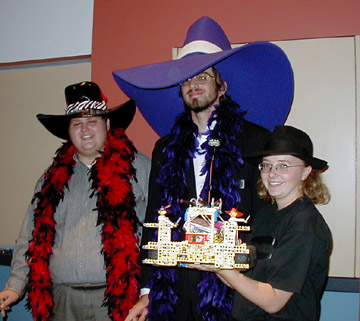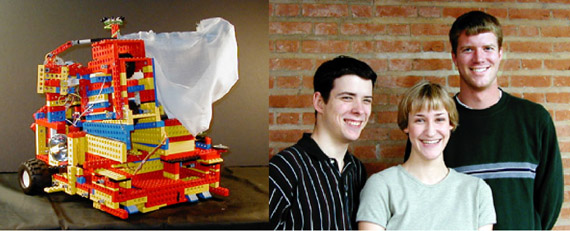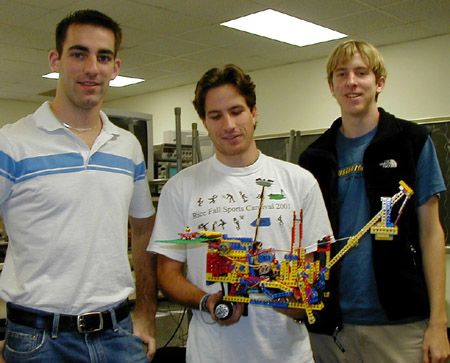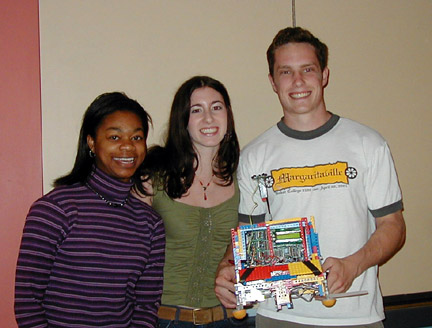![]()
The Year 2003 Game: Robo Tow Truck
The University is in serious financial trouble. The stock market crash plus the expensive construction of a new house for the President, (but not for the Wiess Master) have depleted the endowment. Once again the troubled University has turned to its students for help. The Ass. V. P. for Finance and Student Aggravation has significantly increased parking ticket fines for student vehicles that are not in the correct lots on Monday morning. Your task is to build a robot tow truck to collect the vehicles of your friends on the opposite side of the campus, and to bring them back and place them in your parking lot. You also have to deal with the opposing robot who is trying to collect his set of vehicles. The robot with the most points at the end of the game wins. Strategy, reliability, and speed are important because your opponent can end the game early and stop your scoring. Details
The Winner: Polka-dot Pansy
Daniel Huffaker (senior), Sean O'Brien (senior), and Dane Powell (freshman), all Mechanical Engineering and Jones College, with their robot.
Polka-dot Pansy used a simple, unique strategy to win the contest undefeated. While most robots navigated around the central wall to get to and collect their blocks, Polka-dot Pansy just went rapidly forward to the wall (straddling an opponent's block) and reached over the wall with its arm to grap one of its blocks and return it to its side, scoring 1 point. Another part of its strategy was to use the green flipper to trigger the parking lot gate rapidly three times, thus ending the game before the opponent could score. In fact, they only used this technique once, because just sitting over the opponents blocks effectively blocked all opponents from scoring. No one had (or at least used) a strategy that could deal with the blockade, such as just going for the large SUV block.
The team's success was also due in large part to the reliability of their robot. Because of their common Mechanical Engineer major, they relied primarily on mechanical methods for triggering and releasing the arm and the claw, and used stored energy in rubber bands to power them. Very simple and no programming necessary. Most importantly, they had their robot built in near final form very early in the semester, about week 5, and then spent the rest of the semester testing and improving the weak points. For more details, see their final report web pages. Here is a list of all the 2003 players.
The Year 2002 Game: More is More
The game is the inverse of last year's game, with a twist. There are 13 balls on the table when the game starts, but a ball dispenser will subsequently add two balls during the game, one at 20 and one at 40 seconds into play. Your job is to design a robot to collect and retain balls on your side of the board. At the end of the 60 second game, the robot with the most balls on its side wins. As always, good strategy, ball handling, tracking your opponent, and especially reliability will be important. Details
The Winner: Disco Stu
Tiffany Truss (sophomore, undeclared engineer, Wiess College), Stephanie Clark (sophomore, art major, Baker College), and Gary Printy (senior, ELEC major, Baker College), with their robot Disco Stu.
Disco Stu lost his first game, but went on to win six straight games to reach the final round, where he won against the undefeated Rodomous Prime (Jacob Dickerman, freshman, History, Will Rice College; Jon Noack, senior, computer science, Jones College; Chris Wall, senior, ELEC, Hanszen College). Disco Stu used a simple, elegant strategy. He started at an angle and headed rapidly for the middle ball in the neutral zone, thus avoiding collisions with its opponent and the resulting confusion. When he reached the center black-white boundary, he turned parallel to the boundary, away from the opponent, collected the center ball, followed the boundary to collect a second neutral ball, and continued to the side wall. When his bumper hit the wall, Disco Stu stopped, and triggered the ball dispenser to get a third ball. He then turned toward his own side and went until he hit the back wall. With three extra balls, he would win even if the opponent got the remaining neutral ball and the one from the ball dispenser. After hitting the end wall, Disco Stu turned and swept up all the balls at his end, pushing them into a corner, and just stopped, sitting on them. This made it very hard for a harvester robot to collect any balls, and most who tried got snagged on the immobile Disco Stu, unwittingly delivering more balls. This strategy required only three turns, a bit of line following, and finding a wall. Disco Stu's ability to execute it reliably was the key to his success. Here is a list of all the 2002 players and here are the contest brackets.
The Year 2001 Game: Less is More
The game is deceptively simple; there are 13 balls on the table, and your job is to keep them on your opponent's side of the table. At the end of the 60 second game, the robot with the fewest balls on its side wins. Good strategy, tracking your opponent, ball handling, and especially reliability are important. Details.
The Winner: PimpBot (Extra points for coming in costume!)

Manny "Mac Daddy" de la Mora (Junior, Anthropology), Sid "Chief Sloth Artist" Byrd (Junior, Computer Science), and Kathryn "Kat" Dalton (Senior, Chemistry and Spanish), with their robot PimpBot.
In a hard-fought contest, PimpBot performed almost flawlessly. It used a simple strategy based on power and on tracking the other robot. At the start, it quickly ran across the center line, pushing one ball onto its opponent's side, and running into the other robot. Using 6 drive motors on six wide wheels, it was able to push its opponent back into the wall or a corner, confusing it, and/or physically preventing it from executing its strategy for scoring. The opponent could run, but it couldn't hide: PimpBot used optical sensors to locate the opponent's IR beacon, then tracked it down, and immobilized it. For more details, see their Final Report web site.
PimpBot lost only once (a false start) in 9 games to second place robot Good Lord Willing (Jon Gillespie, freshmen, Mechanical Engineering, and Rebecca Villarreal, freshman, Psychology), a great ball-collecting robot. Honorable mention goes to S&M (Natalie Briaud, Brian Lin, and Tony Pule), also a tracking robot, Augustus Gloop (Bonnie Thomas and Cara Eng), and PacMan (Roy Ha, MIchael Haag, and Jessica Watkins). Here is a pdf file listing all the 2001 players.
The Year 2000 Game: Robo-Pinball
Points are earned by depositing Nerf balls in one or more goals located on the game board. Your robot is given one ball prior to the start of the game, and may obtain others at dispensers located on the board. The various goals have different levels of difficulty and point value. Earn bonus points by shooting balls through a hoop goal from the other side of the table. Details.
The Winner: Stone Cold,Team #20

Andrew Dupre, Senior, Elec. & Computer Engr., Baker College
Sarah Ainsworth, Junior, Cognitive Sciences, Baker College
Kevin Lynch, Senior, Biology, Baker CollegeHonorable Mentions:
- Moo, Laura Derr (3, History/Religious Studies), David Pekker (4, Math/Physics), and Albert Sim (3, Sociology).
- Go Blue!, Scott DiPasquale (3, ECE), Julie Rosser (2, Engineering), and Erik Welsh (4, ECE).
View a complete list of the 2000 robots and teams, in PDF format.


